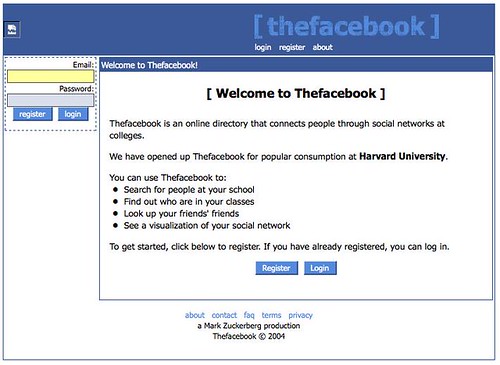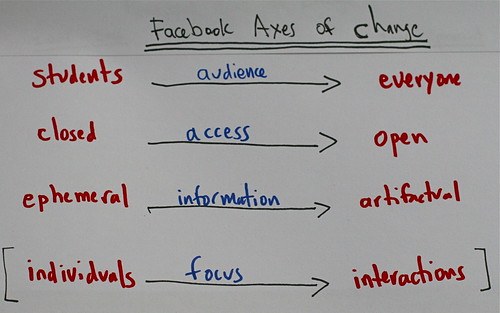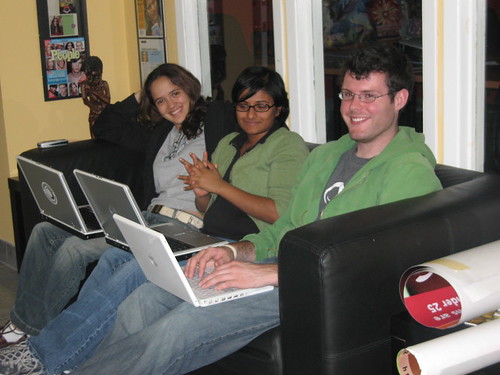The Changing Face of Facebook
academic facebook facebook history thesisOne fascinating thing about Facebook is how much it has changed since it was first launched in 2004. Like the other early social networking sites such as Friendster, Facebook started out with very simple features (check out their early FAQ to see what I mean). But, unlike Friendster and a lot of other sites,* Facebook kept adding features that not only drastically changed how the site works, but increasingly made it insanely addictive. In writing my first chapter for my thesis which summarizes the history of Facebook’s development, I’m realising how important these changes are in understanding not only the culture of Facebook today (especially in Toronto, where many people adopted it earlier there then elsewhere, and thus were witness to a lot of the changes), but also in understanding the state and meaning of social networking sites more broadly.
 As I mentioned, early Facebook was like any other social networking site, except that it was aimed at the niche market of university students. It was the functionality of these sites that gave rise to the term online social networking – you add your friends and in essence make tangible your offline social network. (Something I’m investigating is the development of that term – did the sites actually ever use it themselves, or did the academics/bloggers come up with it?) Anyway, on Friendster back in the day (2003) I remember my friends and I all got excited and spent hours adding everyone we knew. Then we had added everyone, and got bored, and thought “now what?” There was really nothing to do with that meticulously created list of friends. So we all forgot about it. But Facebook went beyond that, and gave us something to do with that list. They’ve made that list your audience, your contact list, your source of information and your entertainment. I think its fair to say that Facebook has gone beyond what we first called a social networking site.
As I mentioned, early Facebook was like any other social networking site, except that it was aimed at the niche market of university students. It was the functionality of these sites that gave rise to the term online social networking – you add your friends and in essence make tangible your offline social network. (Something I’m investigating is the development of that term – did the sites actually ever use it themselves, or did the academics/bloggers come up with it?) Anyway, on Friendster back in the day (2003) I remember my friends and I all got excited and spent hours adding everyone we knew. Then we had added everyone, and got bored, and thought “now what?” There was really nothing to do with that meticulously created list of friends. So we all forgot about it. But Facebook went beyond that, and gave us something to do with that list. They’ve made that list your audience, your contact list, your source of information and your entertainment. I think its fair to say that Facebook has gone beyond what we first called a social networking site.
danah boyd and Nicole Ellison recently proposed that the term should be social network, rather than social networking sites because the latter implies that active searching for and engagement with new people. Facebook and other sites aren’t really about meeting new people, they’re about growing and maintaining existing relationships with people we already know. As we all know, adding someone you don’t know on Facebook has become a total faux pas. For them, the primary characteristic of social network sites, or whatever you want to call them, is that they allow you to create and show your social network. But I think that’s only the beginning of what Facebook is today. That social network is definitely the foundation for all of the other activities on the site, but I don’t think that it’s still the defining characteristic.
 I think the best way to understand how Facebook has gone beyond being just a social networking site is to see how it has evolved from what we meant by social networking site in 2004. Facebook’s three big axes of change can be summarized in terms of access, audience and information the first two of which are closely intertwined. The first Facebook, which was actually officially called thefacebook at the time (pictured courtesy archive.org) was essentially just your profile and a list of your friends, like all good social networks of the time (and still some today).
I think the best way to understand how Facebook has gone beyond being just a social networking site is to see how it has evolved from what we meant by social networking site in 2004. Facebook’s three big axes of change can be summarized in terms of access, audience and information the first two of which are closely intertwined. The first Facebook, which was actually officially called thefacebook at the time (pictured courtesy archive.org) was essentially just your profile and a list of your friends, like all good social networks of the time (and still some today).
Access-wise, early Facebook was closed – you needed a valid email address from an approved school to join, which was just Harvard at first. The audience was students exclusively, and had features specifically for that purpose, such as being able to see who was in your classes. Or helping you get laid, as Karel Baloun, one of the first Facebook engineers, suggests in his book on the subject: “Facebook gives users what they want, which for college students is information about their friends and schoolmates for the purpose of… well … sex. And fun social events, which lead to sex” (Inside Facebook, p 91). And lastly, the information on thefacebook was ephemeral. You could change stuff on your profile, and no one would know unless they went looking and could remember what you had there before. As danah boyd puts it, there was security in obscurity. Closed doors, ephemeral information and a student-only audience made people feel safe sharing their real and personal details about themselves. If only other students will see, and only those I want, it’s okay for me to post my dorm room and mobile number on Facebook. In fact, people felt encouraged to do so. There was a pay off – it made socializing easier. People will give up their privacy if they get something in exchange, like free air travel (Air Miles cards) or convenience (putting your thumb and iris on file to cross the border faster, as with the Nexxus card in North America). It was this closed, student only phase in Facebook’s history that created Facebook’s continuing culture of sharing lots of accurate personal information that gives Facebook its tremendous value. I suspect things would not be the same if Facebook had opened up to everyone right away, since it was still unusual to so closely tie one’s offline life and identity with their online one.
Anyway, as we all know, Facebook opened it’s doors to everyone. Slowly at first, with high school kids first being allowed on (September 2005). Then select companies, such as Apple and Microsoft (May 2006), then everyone (September 2006).** This fateful day in September was also the day that Facebook added the News and Mini-Feeds. It was a double whammy. No longer could you feel projected from the rest of the world by Facebook’s walls of valid-email-requirements and that feel relatively assured that those drunken party photos from last night’s kegger would probably not grace the eyes of your boss.*** In fact, now, your boss would probably get notified that the pictures were posted, via her shiny new News Feed. All at once, everything was different.
First, the information on Facebook that had once been ephemeral was now not only artifactual, but was also being actively pushed to your friends. The formerly invisible act of updating your profile was now visible. Activities change when we know people are watching. They become performative. Now, not only was your profile performative, but the act of maintaining it was also a performance. The addition of feeds made it possible to watch snippets of our friends lives, without having to interact with them or even having them know we watching. It’s the replacement of reciprocal interaction with information flows. The recent redesign has reinforced this informational shift. The default thing you see when you view someone’s profile is no longer their personal and contact information, but the activity from their wall and mini-feeds combined. In fact, you could probably say this is an emerging axis of change on Facebook that is strongly related to the informational shift – a shift in focus from personal information to a focus on one’s activity and interactions with others.
Secondly, Facebook had moved from being closed to open access, and in so doing had changed from catering to students to catering to everyone. This change in audience not only meant changes in Facebook’s affordances to make it more appealing to a mainstream audience (for example, getting rid of the courses feature), but a change in every users’ potential audience. Now all the early adopters had to rethink if that profile they had created when Facebook was students-only was appropriate for everyone in their lives to potentially see.
 I had a bit of an interesting experience with this shift in audience. I had been on Facebook since 2004, but didn’t really use it in the university context since I had already graduated earlier that year. I did, however, use it primarily with people from my personal rather than professional life. But, when Facebook took off in Toronto in late 2006 (pictured in action on the right), I was working at a place that blended the personal and the professional, as I think a lot of young high tech firms do these days. Anyway, it took me a while after Facebook opened up to everyone to realise that my vague feeling of discomfort when using Facebook stemmed from the fact that Facebook had essentially mashed up all my contexts into one big context, yet out of habit, I was still using and thinking about the site as if I was just interacting with close friends in terms of sharing more and different things that I probably would’ve otherwise. From talking to other people about this, I think this experience is common for a lot of early adopters, but I think it may have been even more subtle for me given the culture of where I was working at the time.
I had a bit of an interesting experience with this shift in audience. I had been on Facebook since 2004, but didn’t really use it in the university context since I had already graduated earlier that year. I did, however, use it primarily with people from my personal rather than professional life. But, when Facebook took off in Toronto in late 2006 (pictured in action on the right), I was working at a place that blended the personal and the professional, as I think a lot of young high tech firms do these days. Anyway, it took me a while after Facebook opened up to everyone to realise that my vague feeling of discomfort when using Facebook stemmed from the fact that Facebook had essentially mashed up all my contexts into one big context, yet out of habit, I was still using and thinking about the site as if I was just interacting with close friends in terms of sharing more and different things that I probably would’ve otherwise. From talking to other people about this, I think this experience is common for a lot of early adopters, but I think it may have been even more subtle for me given the culture of where I was working at the time.
So what is Facebook now? I’m still working on it, but it’s more than a social networking site since creating and articulating our networks is definitely only the foundation of what we’re actually doing on Facebook these days. The front page of Facebook (the one you see when you’re logged out) says it’s a “social utility” that can be used to “keep up with friends and family; share photos and videos; control privacy online; and reconnect with old classmates.” But overall, it “connects you with the people around you.” Baloun (remember that Facebook engineer?) says that “everything social can be transacted inside [Facebook]” (Inside Facebook, p 71). While not yet a reality, it’s certainly Zuckerberg’s fantasy of how he wants Facebook to be, and says a lot about what I think is an inherent believe at Facebook: that everything can be reduced to 1s and 0s. Today, Facebook is social networking, but its also life streaming, photo sharing, video sharing, blogging, event organizing and a bunch of other stuff we haven’t got proper names for yet. But take that thought and add this: some would say that like MySpace, Facebook is “the next generation of marketing, advertising and promotion, exquisitely disguised as social networking.” A little scary, no?
—
* Even my favorite, LiveJournal, has remained basically the same since 1999, but it looks like that might be changing since SUP bought them. I haven’t decided if this is good or bad yet, but Facebook has shown that even relatively minor-ish changes like Feeds can change the whole culture, meaning and use of a site.
** Of course, it is important to point out that a lot of the safety in Facebook’s student-only access was psychological. Stuff still leaked out, and school admins and other unwelcome people still got in. But the power of that sort of belief, and the culture of accurate personal information sharing that came from it, cannot be ignored. However, when Facebook opens its doors, the reality of the situation hits you right in the face. Its not easy to go on believing that what you put on Facebook will stay there.
*** Note that both the opening to high school kids and everyone were in September, the start of the school year in North America.
No comments yet.